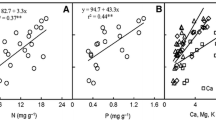Abstract
Polylepis sericea trees grow well above the continuous forest line in the Venezuelan Andes. In these environments, extreme daily temperature ranges can occur at any time of the year and trees experience a 4 month dry period. The purpose of this work was to study carbon and water relations of this species in the field during wet and dry seasons in order to understand this species' success at such high altitudes. Leaf gas exchange (portable system in open mode) and leaf water potential (pressure chamber) were measured at 1–2 h intervals during several daily courses at 4000 m elevation in the Páramo de Piedras Blancas. CO2 assimilation versus leaf temperature curves were also obtained for this species in the laboratory. Clear differences in the measured parameters were observed between seasons. For a wet season day, maximum CO2 assimilation rate was 7.4 μmol m-2 s-1 and leaf conductance was relatively constant (approximately 100 mmol m-2 s-1)In the dry season day, maximum CO2 assimilation rate was 5.8 μmolm-2 s-1 and leaf conductance was close to 60 mmolm-2 s-1. Minimum leaf water potentials measured were -1.3 MPa for the wet and -2.2 MPa for the dry season. The CO2 assimilation-leaf temperature relationship showed a 13.4°C leaf temperature optimum for photosynthesis with maximum and minimum compensation points of 29.5 and -2.8°C, respectively. Maximum night-time respiration was relatively high (2.7 (imol) m-2 s-1)Our results show thatP. sericea maintains a highly positive carbon balance through all daily courses, even though there is a slight water stress effect during the dry season; this suggests that its carbon assimilation machinery is well adapted to the low temperatures and seasonal water stress found in the high tropical mountains.
Similar content being viewed by others
References
Añez MA (1987) Relaciones hídricas y nutricionales en especies arbóreas de un bosque nublado a lo largo de un gradiente sucesional. Unpublished Masters thesis, IVIC, Caracas, Venezuela
Arnal H (1983) Estudio ecológico del bosque alti-andino dePolylepis sericea WEBB en la Cordillera de Mérida. Unpublished Licenciature thesis. Universidad Central de Venezuela. Caracas, Venezuela
Aylett GP (1985) Irradiance interception, leaf conductance and photosynthesis in Jamaican upper montane rain forest trees. Photosynthetica 19: 323–337
Azócar A, Monasterio M (1980) Estudio de la variabilidad meso y microclimática en el Páramo de Mucubají. In: Monasterio M (ed) Estudios Ecológicos de los Páramos Andinos. Ediciones de la Universidad de los Andes. Mérida, Venezuela, pp 225–262
Caemmerer S von, Farquhar GD (1981) Some relationships between the biochemistry of photosynthesis and the gas exchange of leaves. Planta 153: 376–387
Goldstein G, Rada F, Canales MJ, Zabala O (1989) Leaf gas exchange of two giant caulescent rosette species. Acta Oecol 10: 359–370
Goldstein G, Meinzer FC, Rada F (1994) Environmental biology of a tropical treeline species,Polylepis sericea. In: Rundel PW, Smith AP, Meinzer FC (eds) Tropical alpine environments: plant form and function. Cambridge University Press, Cambridge, pp 129–149
Larcher W (1961) Jahresgang des Assimilations- und Respirationsvermögens vonOlea europea L. spp.sativa Hoff. et Link,Quercus ilex L. undQuercus pubescens Willd. aus dem nördlichen Gardaseegebiet. Planta 56: 575–606
Larcher W (1975) Pflanzenökologische Beobachtungen in der Paramostufe der Venezolanischen Anden. Anz math-naturw. Kl Österr Akad Wiss 11: 194–213
Levitt J (1980) Responses of plants to environmental stresses, vol 1. Chilling, freezing and high temperature stresses, Academic Press, New York
McCree KJ, Kallsen CE, Richardson SG (1984) Carbon balance of sorghum plants during osmotic adjustment to water stress. Plant Physiol 76: 898–902
Meinzer F, Goldstein G, Jaimes M (1984) The effect of atmospheric humidity on stomatal control of gas exchange in two tropical coniferous species. Can J Bot 62: 591–595
Monasterio M (1980) Las formaciones vegetales de los páramos de Venezuela. In: Monasterio M (ed) Estudios Ecológicos de los Páramos Andinos. Ediciones de la Universidad de los Andes. Mérida, Venezuela, pp 93–158
Rada F (1983) Mecanismos de resistencia a temperaturas congelantes enEspeletia spicata yPolylepis sericea. Unpublished M. Sc. thesis. Universidad de los Andes. Mérida, Venezuela
Rada F, Goldstein G, Azócar A, Meinzer F (1985) Daily and seasonal osmotic changes in a tropical treeline species. J Exp Bot 36: 989–1000
Rada F, González J, Azócar A, Briceño B, Jaimez R (1992) Net photosynthesis-leaf temperature relations in plant species with different height along an altitudinal gradient. Acta Oecol 13: 535–542
Schulze ED (1982) Plant life forms and their carbon, water and nutrient relations. In: Lange OL, Nobel PS, Osmond CB, Ziegler H (eds) Encyclopedia of plant physiology, physiological plant ecology. II., vol 12B. Springer, Berlin Heidelberg New York, pp 616–676
Schulze ED, Beck E, Scheibe R, Ziegler P (1985) Carbon dioxide assimilation and stomatal response of Afroalpine giant rosette plants. Oecologia 65: 207–213
Simpson B (1979) A review of the genusPolylepis (Rosaceae: Sanguisorbeae). Smithsonian Contributions to Botany, No. 43
Tranquillini W (1979) Physiological ecology of the alpine timberline. Springer, Berlin Heidelberg New York
Walter H, Medina E (1969) La temperatura del suelo como factor determinante para la caracterización de los pisos subalpino y alpino de los Andes de Venezuela. Bol Soc Venez Cienc Nat 115/116: 201–210
Author information
Authors and Affiliations
Rights and permissions
About this article
Cite this article
Rada, F., Azócar, A., Briceño, B. et al. Carbon and water balance in Polylepis sericea, a tropical treeline species. Trees 10, 218–222 (1996). https://doi.org/10.1007/BF02185672
Received:
Accepted:
Issue Date:
DOI: https://doi.org/10.1007/BF02185672




